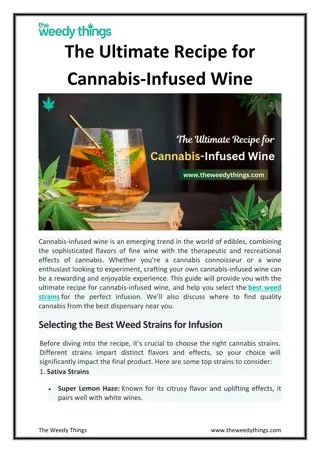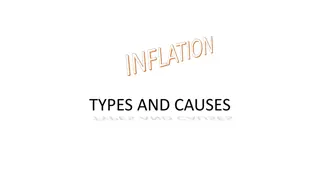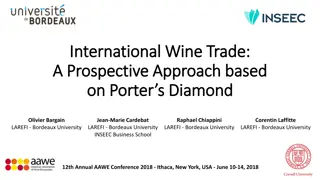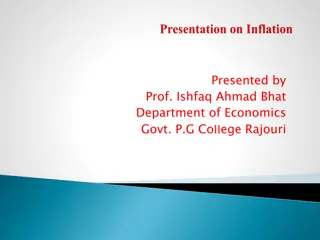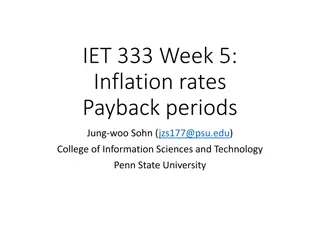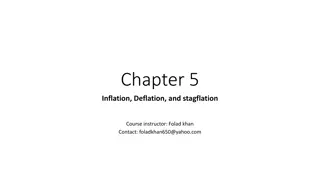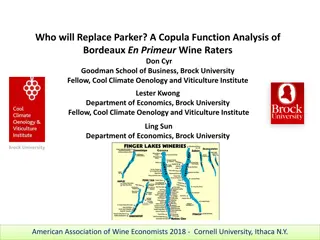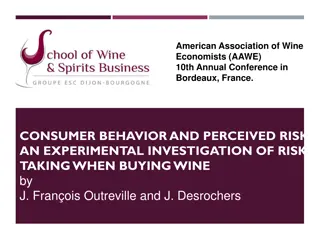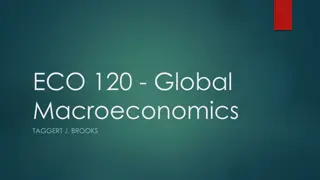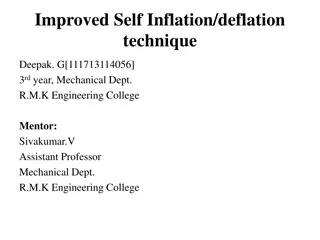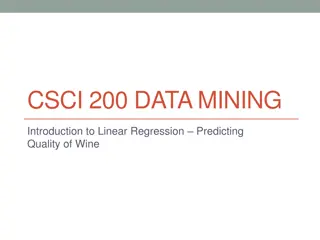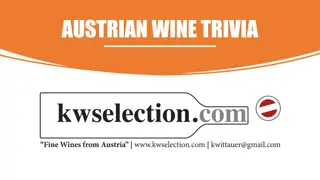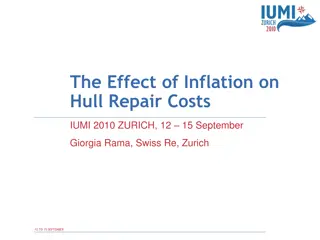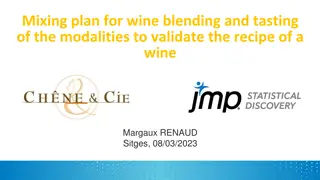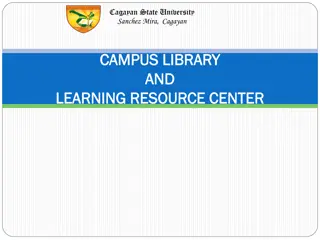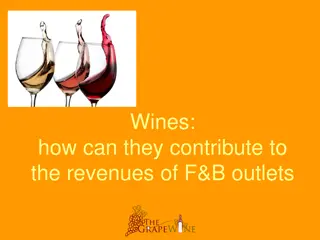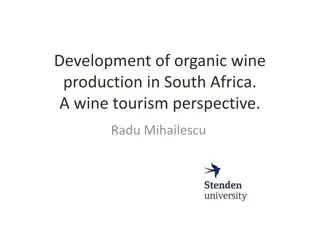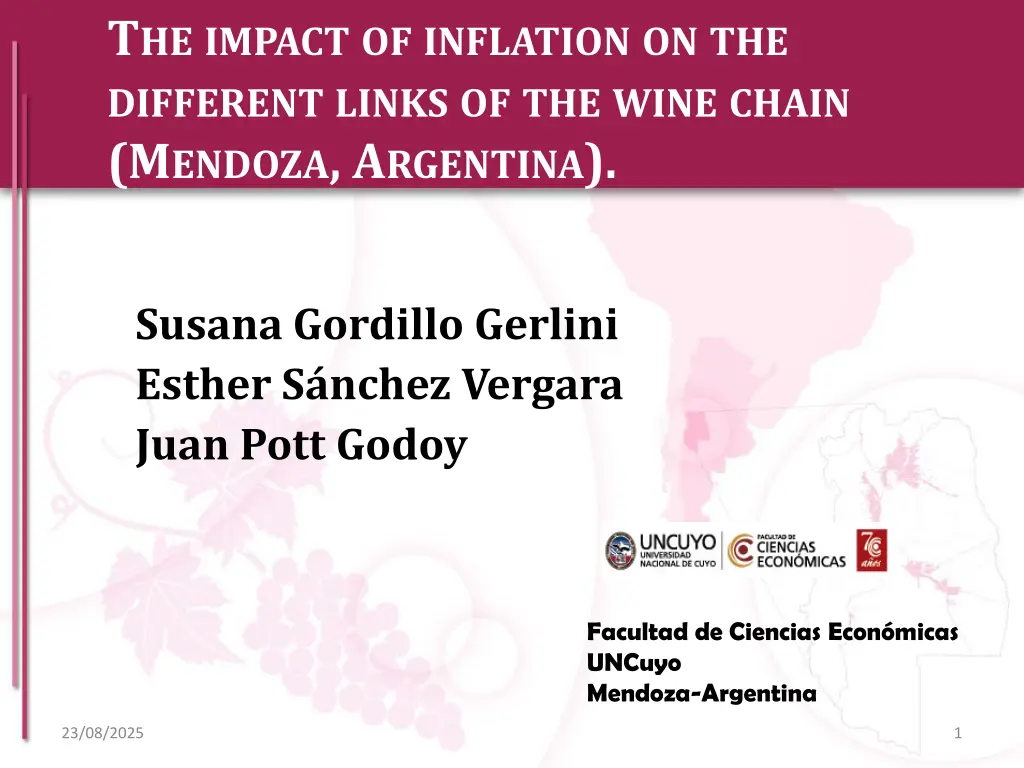
Impact of Inflation on Mendoza's Wine Industry
Explore the impact of inflation on different links of the wine chain in Mendoza, Argentina, tracing the industry's growth, evolution, and challenges over the years. Discover how external factors like macroeconomics and inflation asymmetrically affect various aspects of the wine industry.
Download Presentation

Please find below an Image/Link to download the presentation.
The content on the website is provided AS IS for your information and personal use only. It may not be sold, licensed, or shared on other websites without obtaining consent from the author. If you encounter any issues during the download, it is possible that the publisher has removed the file from their server.
You are allowed to download the files provided on this website for personal or commercial use, subject to the condition that they are used lawfully. All files are the property of their respective owners.
The content on the website is provided AS IS for your information and personal use only. It may not be sold, licensed, or shared on other websites without obtaining consent from the author.
E N D
Presentation Transcript
THE IMPACT OF INFLATION ON THE DIFFERENT LINKS OF THE WINE CHAIN (MENDOZA, ARGENTINA). Susana Gordillo Gerlini Esther S nchez Vergara Juan Pott Godoy Facultad de Ciencias Econ micas UNCuyo Mendoza-Argentina 23/08/2025 1
One cluster in growth , evolution and Mendoza's wine industry expanded in the late XIX century as the immigration of mainly Italians and Spaniards, who developed an agricultural model much alike the one from their hometowns: small and medium-sized family farms. During the 50s and 70s of the last century crops expanded extremely encouraged by a promoting and intervening state regulation. Although in recent years, as in other wine regions of the world, production has expanded to non-traditional locations, Mendoza remains the leading producer and processor of wines from Argentina. 23/08/2025 2
overproduction and big transformations Several crisis of overproduction occurred in the Mendoza wine industry until the 90s, during a period of liberalization of the national economic policy, when the wine industry was profoundly transformed. The axis of these transformations was foreign investment, which by incorporating technology and knowledge made possible an extraordinary advance in the quality of wines and further expansion of exports. 23/08/2025 3
The wine industry is most that one activity During the first decade of the XXI century the industry continued with its growth and expansion, especially after the devaluation of the Argentine peso in 2002, it resisted even the international financial crisis of 2008, until 2014 when it showed a severe crisis. The wine industry is not only important in production volume, for the people of Mendoza it is their "mother industry"; hence vineyards represent an important social heritage and constitute the hallmarks of the people of Mendoza. The cluster is very heterogenous and the external factors like a macroeconomics or inflation are most asymmetrics impacts in diferent links on chain . 4
Grapes Market (Mendoza) Mendoza's wine industry is very heterogeneous in growing areas, varieties, actors and income levels. The geography and climate characteristics of Mendoza are ideal for the development of numerous varieties and crops, and currently tests are done with new varieties for the area. Almost all varieties are grown in the five oasis, but they produce wines of different qualities due to the differences in soil and temperature between the various zones. In the last years the price paid for the grapes to the primary producer has not increased at the same rate as domestic inflation. 23/08/2025 5
Current situation: From overstocks to inflation (I) Stagnant prices for grapes (decreasing in US dollars), with rising costs for wine production, have led many producers to protest in the streets demanding solutions in 2014 and 2015. Many wine growers that reconverted their crops are having loses nowadays. On the other hand, many hectare grown with grapes without oenological value are maintained. The market for grapes shows imperfections which are difficult to correct. The situation has become really worrying and all associations have called for aid to the government. Many speak of negative returns, of the inability to meet the costs of harvesting, etc. 23/08/2025 6
Current situation: From overstocks to inflation (II) What is happening with the price transmission in the wine value chain? For many years there has already been a significant difference in the price paid to the producer and the price paid by the consumer and that during the current crisis the commercial segment continued to increase consumer prices, further aggravating the fall in domestic consumption. 23/08/2025 7
Market power The market of basic wines would represent an oligopoly "bilateral unbalanced" because only 3 companies hold 90% of the market. While in the market of varietal wines there are numerous wineries with the presence of numerous brands. In the wine industry the atomized structure of the primary production implies weak power of negotiation and it is the reason why the adjustments in the value chain are easier backwards (price of the raw material -grape) while forwards (for distribution and marketing) the power is attenuated by the existence of large distribution chains and similar substitute products such as beer. 23/08/2025 8
Since the 2014 harvest Many crops have been abandoned. Many wineries haven t bought grapes, they have only accepted grapes to process. They have postponed payments for 12 months (without interest) Months before the 2015 harvest the wineries warned about an important stock of unsold wine and suggested that it would be better to leave the grapes at the vine . Around 20% of the wineries did not produce wine in 2015. The prices paid for the grapes did not cover the growing and harvesting costs. 23/08/2025 9
Inflation in Argentina: a long history Argentina has suffered in the past different inflationary and even hyperinflationary cycles that have had different effects on the production of goods and services, especially in the relative prices of the same. By changing the relative prices of goods some agents lose purchasing power while others gain. The anti-inflationary policies applied after the inflationary episodes have also been very numerous with the use of different foundations, instruments and results. 23/08/2025 10
Inflation and Asymmetries Subsequent adjustment of prices also produce different effects on economic actors. The Argentine wine chain is very heterogeneous, it has numerous actors that participate from the production of grapes to the commercialization, going through the production of wines and by- products, the picking agents or transfers, the warehouses "fraccionadoras" until the marketing agents. In addition, since winemaking in Argentina has its origins in the colonial period, due to the long time elapsed since then, the actors have developed habits and customs that are deeply rooted today. Simultaneously, a complex and profuse state regulation has been created and justified by dominant market players and also from the state itself in order to protect the weakest. Likewise, each one of the wine chain agents has developed different expectations regarding inflation, adjustments and the legislation putting in place initiatives and ways to protect their profitability, both in the inflation period and in the later adjustments. 23/08/2025 11
The worst part is for the little ones In the last inflationary period, which began in 2007, the effects were not distributed equally in all actors of the chain. In other words, companies face certain problems whose solution exceeds their own framework. In particular, those related to the conditions of the general context in which their activities are carried out and result in a more or less viable sustainability of the sector of the economy to which they belong. This is what happened in Argentina during the period 2007-15. The work we present seeks to analyze how the inflationary effect was distributed over each link in the chain in 2007-15 and to deepen the consequences of it. 23/08/2025 12
Evolution of the CPI (Jan-06/Mar-17) Evolution of the Consumer Price Index (Jan-06 / Mar-17) 1400 1200 1000 800 600 400 200 0 may.-15 may.-06 may.-07 may.-08 may.-09 may.-10 may.-11 may.-12 may.-13 may.-14 may.-16 sep.-06 sep.-07 sep.-08 sep.-09 sep.-10 sep.-11 sep.-12 sep.-13 sep.-14 sep.-15 sep.-16 jan.-11 jan.-06 jan.-07 jan.-08 jan.-09 jan.-10 jan.-12 jan.-13 jan.-14 jan.-15 jan.-16 jan.-17 IPC (Base Jan-06=100) 23/08/2025 13
Impact of inflation on grape producers Evolution of the grape producers situation (2005 - 2016) Quintals harvested in Argentina (Qq) 1200 35.000.000 1100 Price Index (Base 2.005=100) 30.000.000 1000 900 25.000.000 800 700 20.000.000 600 15.000.000 500 400 10.000.000 300 200 5.000.000 100 0 0 2.005 2.006 2.007 2.008 2.009 2.010 2.011 2.012 2.013 2.014 2.015 2.016 Year Qq Grape price IPC 23/08/2025 14
Asymmetrics effects on the red wine chain Behavior of prices in the different links of the red wine chain (Jan-10 / Feb-16) 500 500 Grape Price Index (Base 2010 harves=100) Wine to final consumer Price variation in the period Grape Bulk wine IPC 450 450 Price Index (Base Jan.-10=100) 400 400 In nominal terms In real terms 18% -68% 65% -64% 183% -39% 363% 350 350 300 300 250 250 200 200 150 150 100 100 50 50 0 0 oct.-10 oct.-11 oct.-12 oct.-13 oct.-14 oct.-15 apr.-10 apr.-11 apr.-12 apr.-14 apr.-15 jan.-16 jul.-13 jan.-10 jul.-10 jan.-11 jul.-11 jan.-12 jul.-12 jan.-13 jan.-14 jul.-14 jan.-15 jul.-15 apr..-13 Month - Year Common red grape Red bulk wine Red wine to final consumer IPC 23/08/2025 15
Asymmetrics effects on the white wine chain Behavior of prices in the different links of the white wine chain (Jan-10 / Feb-16) 500 500 Wine to final consumer Grape Price Index (Base 2010 harvest=100) Price variation in the period Grape Bulk wine IPC 450 450 Price Index (Base Jan.-10=100) 400 400 In nominal terms In real terms 13% -70% 78% -61% 201% -35% 363% 350 350 300 300 250 250 200 200 150 150 100 100 50 50 0 0 apr.-15 jan.-10 apr.-10 jul.-10 jan.-11 apr.-11 jul.-11 jan.-12 apr.-12 jul.-12 jan.-13 jul.-13 jan.-14 apr.-14 jul.-14 jan.-15 jul.-15 jan.-16 oct.-10 oct.-11 oct.-12 apr..-13 oct.-13 oct.-14 oct.-15 Month - Year Common white grape White bulk wine Wine to final consumer IPC 23/08/2025 16
Conclusions Argentina has experienced an important inflationary process in the last 12 years. This inflationary process has had a strong negative impact on the profitability of the wine sector. However, the deterioration of profitability varied in intensity along the different links in the wine chain. The hardest hit was the primary link as the price of the grape had a loss in real terms while its operating costs increased at the rate of inflation. The second link in the chain, the manufacturing wineries, had an average impact since the price of its raw material (grape) had a similar behavior to the price of its final product (bulk wine). 23/08/2025 17
Conclusions The third link in the chain, the commercialization of fractionated wine, was the link that had the least deterioration since the price of wine to final consumer had less loss in real terms than the price of the bulk wine. The unequal distribution of the inflationary impact along the various links in the chain can be easily understood by analyzing the structure of each link. At one extreme we find many small producers with very low bargaining power. At the other extreme are large corporations with high bargaining power. The Argentine wine sector has much to offer but it is a long- term business that requires a stable macroeconomic framework in which sustainable growth can be projected. 23/08/2025 18
Bibliografa Facultad de Ciencias Econ micas de La UNCuyo y Fondo Vitivin cola Mendoza, Impacto de la vitivinicultura en la econom a argentina , 2012, Mendoza. Cavallo, A., Bertolotto, M., Filling the gap in Argentina s Inflation data , Mayo 2016, disp en www.mit.edu Gordillo, Susana, The semi-hidden factors in the wine crisis of Mendoza . AAWE, 2015, Mendoza. S nchez, Esther y Graffigna, M. Elena, La nueva etapa del sector vitivin cola argentino , Cap 18, de La econom a del vino en Espa a y en el mundo Castillo Valero J.S. y Comp s L pez J. Ed Cajamar, 2014, Madrid. Estad sticas: Bolsa de Comercio de Mendoza, Instituto Nacional de Vitivinicultura, Observatorio Vitivin cla Argentino. 23/08/2025 19

